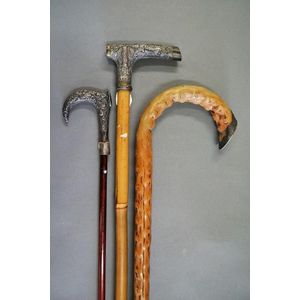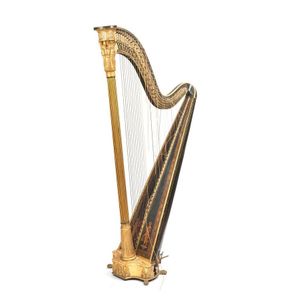Erard's Gilded Harp: 19th Century Masterpiece
You must be a subscriber, and be logged in to view price and dealer details.
Subscribe Now to view actual auction price for this item
When you subscribe, you have the option of setting the currency in which to display prices to $Au, $US, $NZ or Stg.
- Gilding - Gilding is a method of ornamentation whereby a thin sheet of gold metal is applied to items made of wood, leather, ceramics, glass and silver for decorative purposes.
For furniture including mirrors, the sheet of gold is usually applied over a coating of gesso. Gesso is a mixture of plaster of Paris and gypsum mixed with water and then applied to the carved wooden frames of mirrors and picture frames as a base for applying the gold leaf. After numerous coats of gesso have been applied, allowed to dry and then sanded a coat of "bole", a usually red coloured mixture of clay and glue is brushed on and allowed to dry, after which the gold leaf is applied. Over time parts of the gilding will rub off so the base colour can be seen. In water gilding, this was generally a blue colour, while in oil gilding, the under layer was often yellow. In Victorian times, gilders frequently used red as a pigment beneath the gold leaf.
Metal was often gilded by a process known as fire gilding. Gold mixed with mercury was applied and heated, causing the mercury to evaporate, the long-term effect of which was to kill or disable the craftsman or woman from mercury poisoning. The pursuit of beauty has claimed many victims, not the least of which were the artists who made those pieces so highly sought after today. - Erard - The distinguished Parisian firm Erard?s, makers of harps and pianos, were in business between 1777 and 1960.
The business was founded by Sebastien Erard, who had been apprentice to a Parisian harpsichord maker for two years before establishing his own workshop in the rue de Bourbon. In 1786 the company expanded by opening a branch in London, and in 1789 his brother Jean-Baptiste joined as partner.
Sebastien Erard obtained a number of patent registrations in both England and France, for design innovations to both the harp and piano, the most important being for the double-action harp in 1810, the forerunner to today's concert harp.
This item has been included into following indexes:
Visually similar items

A gold, diamond and seedpearl brooch The jewelled gold novelty brooch designed as a harp, length approximately 59 mm. Property from the Collection of Dame Nellie Melba GBE

Three walking canes, one with Indian silver mounts. One with engraved silver mounts, maker 'Kingston & Co', engraved 'Hal From Fred, Xmas '98'. One with engraved handle, hallmarked Birmingham 1885. Approx 84 cm, 97 cm & 102 cm long (3)

A Massim Region canoe prow Splitter with Its canoe ornament, Taburi, the ornament served a protective function, 111.5 cm high with ornament.

A Fijian Kiakavo club, 18/19th century, finely carved from a single piece of hardwood, the striking section with raised detail and very old patina. Provenance: Robert Henry Pulleine (1869-1935), physician and naturalist, was born on 7 June 1869 at Picton,
